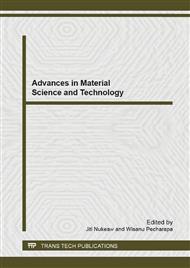p.139
p.144
p.149
p.154
p.159
p.164
p.169
p.174
p.179
Influence of Aluminium on the Color, Microstructure and Hardness of White Alloys
Abstract:
The objective of this paper was to study the influence of aluminium on the color, microstructure and hardness of the as-cast nickel-free white alloys. In order to specify the suitable aluminium content, aluminium in each composition varied from 0, 1, 2, 3, 4 and 5 wt% were investigated. The CIE LAB color system was selected to describe the color of alloys. The results indicated that the increase in the aluminium contents, red-green values (a*) were gradually increased, but yellow-blue values (b*) were slightly decreased. No correlation had been found between the aluminium content and lightness (L*). The microstructures of alloys consisted of the alpha, beta phases and small particles. The hardness of alloys was increased with increasing in the aluminium contents. It was distinct that the hardness of aluminium-free alloy (117 HV) was the lowest value in comparison with other alloys. The obtained results suggested that the variation in the aluminium contents of had a pronounced effect on the increasing hardness and the development of structures. However, the aluminium addition in the ranges of 1.3-5.1wt% resulted in a gradual changing the color.
Info:
Periodical:
Pages:
159-163
Citation:
Online since:
September 2013
Authors:
Keywords:
Price:
Сopyright:
© 2013 Trans Tech Publications Ltd. All Rights Reserved
Share:
Citation:


